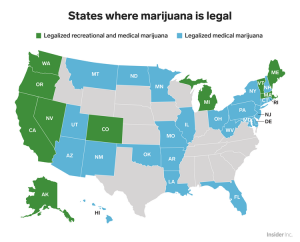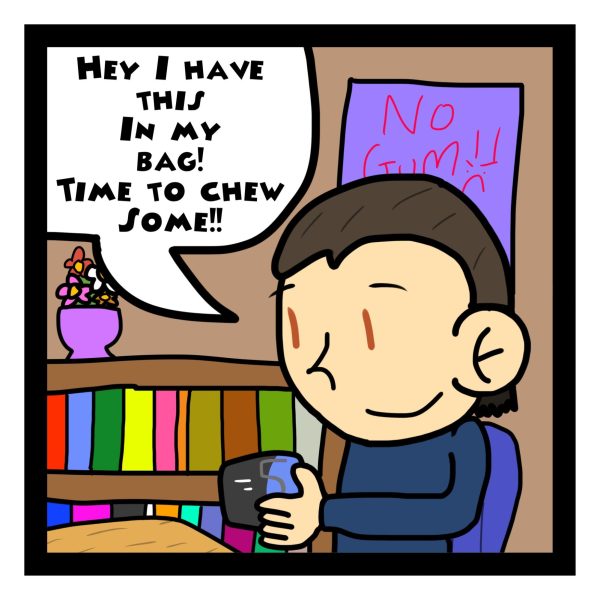Against the Legalization of Marijuana

May 30, 2019
Smoking Pot Presents a Clear Threat to Users
Marijuana is potentially addictive. Although cannabis might not be physiologically addictive, its effects can still be linked to some form of dependence following long-term consumption, according to Royal Queen Seeds, a cannabis seed producer. This is because of the relationship cannabis has with a chemical in our brain called dopamine. In recent decades, research has found that addiction to drugs like cocaine, heroin and methamphetamine is because of dependence on dopamine according to David Hirschman of Big Think, which aims to be an online platform where experts can weigh in on current issues.
Dr. Nora Volkow, the director of the National Institute on Drug Abuse, says that the way the brain becomes addicted to a drug is correlated to the drug increasing levels of naturally-occurring dopamine, which modulates the brain’s ability to perceive reward reinforcement. The pleasure sensation that the brain gets when dopamine levels are elevated creates the motivation for us to proactively perform actions that are indispensable to our survival (like eating or procreation).
Decreases in dopamine function are observed during drug withdrawal, including cannabis-withdrawal syndrome. Despite misconceptions that cannabis is unique from other drugs of abuse, cannabis exerts identical effects on the dopamine system according to Cold Spring Harbor Perspectives in Medicine.
Younger people tend to have more easily addictive personalities. Teenage rats have a much stronger reaction in the brain region involved in habit-formation after they receive a reward. By comparing the brain’s response to a food reward in adult and teen rats, researchers have pinpointed some differences that might explain why adolescents take more risks and are more prone to addiction, depression, and schizophrenia according to Jennifer Welsh of Live Science, a science news website.
Marijuana use has been linked to Psychosis. You know the feeling you get when you’re high? That calming feeling—like for a moment you’re disconnected from reality? That feeling can get out of control the more you get high.
Over the past decade, multiple studies have shown that marijuana use in adolescence can be a contributing factor in triggering or worsening the symptoms of serious psychotic mental illnesses, most notably schizophrenia. Young people with a predisposition to developing a psychotic illness may be drawn to pot at an earlier age than other adolescents according to Juliann Garey of Child Mind Institute, a research organization.
We are not suggesting that smoking pot causes schizophrenia, but both heavy use and an increase in use from occasional to daily — as well as earlier and longer exposure to pot — have been linked to psychosis.
“Evidence suggests that pot smoking can lead to earlier onset — that it can develop it sooner than it would have otherwise,” says Dr. Birnbaum, a child and adolescent psychiatrist at Northwell Health. “Pot is also associated with [the] development of illness in otherwise healthy individuals, meaning it is possible that psychosis would not have developed in that person if they had never smoked pot . . . Although these may be triggered by pot use, discontinuing the usage of pot will not stop the symptoms. If pot turns on that switch, it’s not something that can be easily turned off,” said Dr. Birnbaum.
Any smoke inhalation increases the risk of lung cancer. Marijuana smoke, like cigarette smoke, contains known carcinogens. There is considerable evidence that cigarette smoking is related to lung cancer and many other health hazards. It took decades to demonstrate this. The widespread use of marijuana for recreational uses is a relatively new phenomenon. With time and more research, marijuana smoke may very well prove to be as lethal as cigarette smoke according to Garey.
Decriminalization Puts the Safety of Non-Users in Jeopardy
Marijuana may increase a user’s likelihood of participating in violent behavior. A 50-year study finds a link between cannabis and subsequent violent behavior. New research from Psychological Medicine, a medical journal, concludes that continued use of cannabis causes violent behavior as a direct result of changes in brain function that are caused by smoking marijuana over many years.
The study, called the Cambridge Study in Delinquent Development, was done with 411 boys born around 1953 living in working-class urban neighborhoods of London, 97 percent of whom were Caucasian and all of whom were raised in two-parent households. The researchers noted other factors, including antisocial traits as assessed by the Antisocial Personality Scale, alcohol use, other drug use, cigarette smoking, mental illnesses, and family history.
Most of the participants never used cannabis and they were never reported to have violent behavior. 38% of the participants did try cannabis at least once in their life. Most of them experimented with cannabis in their teens, but then stopped using it. 20% of the boys who started using pot by age 18 continued to use it through middle age (32-48 years). Additionally, 22 percent of those who were pot smokers reported violent behavior that began after beginning to use cannabis, whereas only 0.3 percent reported violence before using marijuana.
Continued use of cannabis over the lifetime of the study was the strongest predictor of violent convictions, even when the other factors that contribute to violent behavior were considered in the statistical analysis.
The results show that continued cannabis use is associated with 7-times greater odds for the subsequent commission of violent crimes. The authors suggest that impairments in neurological circuits controlling behavior may underlie impulsive, violent behavior, as a result of cannabis altering the normal neural functioning in the ventrolateral prefrontal cortex.
Where marijuana is legal, there will likely be more people Driving Under the Influence (DUI). You probably know that drunk driving is a problem. “Driving Under the Influence” can also come in the form of driving while high, which is becoming an issue in states that have decriminalized recreational marijuana use. When you are high, your judgment is passively impaired. You can’t be trusted to make responsible decisions.
In Colorado, where pot sales began in 2014, 69 percent of pot users said they had driven while high at least once in the past year and 27 percent said they drove stoned almost daily, according to preliminary survey results released by that state’s transportation department in April. The number of fatal car accidents in Colorado increased by 40 percent from 2013 to 2015. Drivers in fatal accidents testing positive for pot rose by 145 percent from 2013 to 2016, according to a 2017 Denver Post analysis.
In Washington state, where pot sales began in July 2014, 20 percent of those driving during the daytime are high, up from less than 10 percent before legalization, a state survey found. And the number of motorists who tested positive for both alcohol and drugs following a fatal crash has increased 15 percent every year since 2012, according to the Washington Traffic Safety Commission.
Marilyn Huestis, a toxicologist and adjunct professor of epidemiology and public health at the University of Maryland School of Medicine said that It’s important for the public to recognize that marijuana does impair driving, Huestis said. The drug affects the way people drive in two major ways. One way is by affecting two regions of the brain — the cerebellum and basal ganglia — that are involved in planning and controlling the muscle movements. Such movements are needed to control a car during driving. “When you’re driving, you need to stay in your lane, but cannabis increases weaving within a lane,” Huestis said.
People are affected by marijuana differently so it is difficult to test for. When you are pulled over for drinking in Connecticut, you are given a breathalyzer that tests the amount of alcohol in your system. You cannot test marijuana this way.
Recent research clearly shows that the levels of marijuana’s active compound, called tetrahydrocannabinol (THC), don’t line up in a straightforward way with how impaired people are, according to the paper, published in the journal Trends in Molecular Medicine. In other words, your level of impairment doesn’t depend on the amount of weed you’ve smoked.
If someone takes an edible, it will not be detectable on your breath.
Additionally, research has shown that THC is unlike alcohol, which dissolves in water and is therefore easy to flush from the body. People who use marijuana frequently may have large amounts of THC stored in their tissues, and so no test for THC can distinguish whether someone smoked marijuana today or a month ago, according to Huestis.
A Society Infiltrated by Marijuana (A New Drug) Is Not Ideal
It is very hard to repeal laws after they have been passed. Why can’t we criminalize alcohol, which is regularly regarded as more dangerous than marijuana? We are used to it. We all know that Prohibition was extremely unpopular with the American population.
Another example of our inability to repeal something potentially harmful is the Affordable Care Act (ACA). The ACA has many flaws including rising premiums for plans sold in state marketplaces, high deductibles, and burdensome taxes. But, according to Mike DeBonis of The Washington Post, the law has expanded health insurance coverage to roughly 20 million Americans.
Tom Susman, a Charleston-based strategist, says the issue is more serious than those opposed would like to think. “If you don’t have a replacement, then you do serious damage … you hurt people.”
Of course, marijuana doesn’t provide healthcare to millions of people. In fact, marijuana has not been used long enough for us to know the long-term harms of public use. We do not want to evoke irreversible damage. We haven’t been able to do research on the effects of marijuana. If it is too dangerous to investigate its effects, why isn’t it too dangerous to legalize?
In states where it is legal, marijuana legalization has not had the economic benefits it was supposed to have. One year after marijuana was legalized in California, sales are down, tax revenues are below forecasts, and the black market is thriving.
Around $2.5 billion of legal cannabis was sold in California in 2018, half a billion dollars less than in 2017 when only medical marijuana was legal, according to GreenEdge, a sales tracking company.
California produced a massive surplus of marijuana — the state produces far more pot than it can consume. In basic economic terms, this means that the only way to sell all of it is to drive prices down to levels that likely will not make the producers profit (which is especially likely when you consider the taxes they face).
According to Thomas Fuller of the New York Times, The tons of extra cannabis continues to leech out of California into states where it is illegal.
“The bottom line is that there’s always been a robust illicit market in California — and it’s still there,” said Tom Adams of BDS Analytics, which tracks the cannabis market. “Regulators ignored that and thought they could go straight into an incredibly strict and high-tax environment.”
Think about it, if smoking pot becomes legal, you will probably continue using a black market pot dealer. You could continue using going to your pot dealer who you have built a relationship with and you trust, and the marijuana may even be cheaper than that sold by the government because it isn’t taxable — why would you stop going to that person?
The government should protect its people. Aristotle believed that the government should be a reflection of the ideal society and should promote virtuous moral judgment. People often do not think ahead to the consequences of their actions and just because people make bad decisions doesn’t mean we should just accept it and start regulating people’s exposure.
Why bow down to the short-sighted, self-destructive will of humans?
It is clear that legalizing anything makes it much more prevalent in society simply because it is more accessible. What is good about having more people use an addictive, risky substance?
Another unintended effect is that making something more prevalent allows it to end up more easily in the hands of kids.
According to Headset, a research company, the data suggest that smokers in the customer loyalty program while customers range from ages 21 to 95, over 50 percent of loyalty members are under 40.
When the FDA decided to ease regulations on vaporizers, we saw an exponential increase in teen usage. We do not want the same thing to happen with marijuana.
Some people argue for freedom of choice but we have these freedoms to an extent: if your freedoms inhibit someone else from their freedoms they become dangerous and are therefore illegal and undesirable in a free society.















